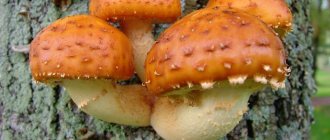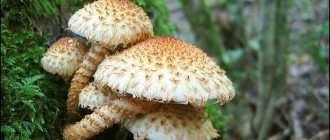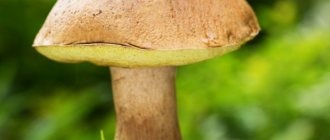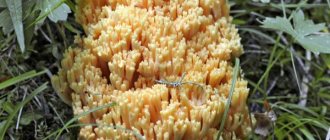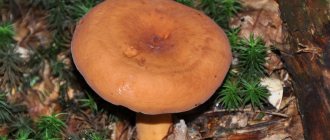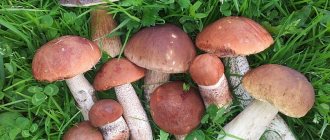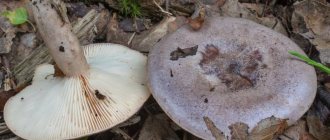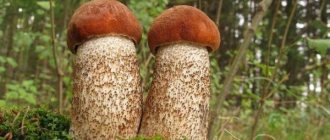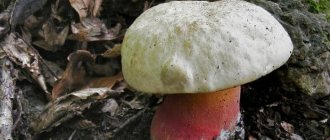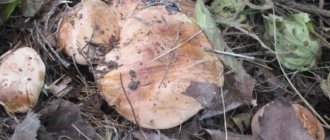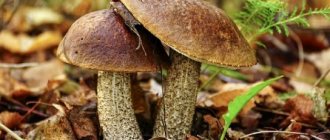BIOLOGICAL CLASSIFICATION OF THE SCALE MUSHROOM
- THEY BELONG TO THE KINGDOM → MUSHROOMS
- BELONG TO THE DEPARTMENT → BASIDIOMYCOTE
- TO CLASS → AGARICOMYCETES
- SUBCLASS → AGARICOMYCETES
- ORDER → AGARIC
- FAMILY → STROPHARIADS
- RODU → SCALE or FOLIOT
Foliota (birch tree, lepiota scaly, royal honey fungus, willow) comes from the strophariaceae family. They are not popular among mushroom pickers, which is why in Russia it is not customary to eat them. Although they are the ones who decorate the autumn forests and paint them with bright colors. Although in Asian countries such as Japan and China, their cultivation has been put into industrial production.
Most of these bright “prickly” mushrooms are not edible, but mushrooms with edible pulp are held in high regard not only by experienced mushroom pickers, but also by supporters of a healthy lifestyle, for their beneficial properties for the body and similarity in taste to real honey mushrooms.
The use of flakes in cooking
In cooking, golden flake is most often used, which contains a variety of amino acids and a large number of microelements. Among other things, fruiting bodies are characterized by low calorie content, therefore they are very useful for vegetarians and those who follow a low-calorie diet.
In terms of the amount of calcium and phosphorus, mushroom pulp can become a worthy alternative to sea and river fish.
In many European countries, royal honey mushrooms are unfairly classified as inedible or low-nutritive mushrooms, which is why their fruiting bodies are extremely rarely used for food purposes. In our country, along with ordinary edible honey mushrooms, golden flakes, rich in many vitamins and having quite tasty pulp, are used to prepare many healthy and nutritious dishes.
Also read: Edible, inedible and poisonous mushrooms growing on a tree
Fire scale
It is important to remember that in order for the fruiting bodies not to cause problems with the digestive tract or gastric upset, after cleaning from forest debris and washing, the mushrooms undergo mandatory preliminary preparation in the form of boiling in a sufficient amount of water.
The fruiting bodies prepared in this way are then used to cook delicious mushroom soups, fry, prepare pie fillings or vegetarian pizza. Chopped mushroom pulp is added to a variety of vegetable stews and stewed vegetables. For preparing dishes, it is recommended to use only mushroom caps, and it is quite possible to marinate and pickle royal mushrooms with the legs.
COMB SCALE
People call it coal-loving, because the slimy cap is rarely not stained with dirt or soot, due to the fact that this fungus most often grows on the remains of fireplaces and burnt trees. That's why mushrooms turn into dirty brown and dirty yellow. Almost like all mushrooms of this species, the young scale is covered with a veil, which, as the mushroom grows in size, becomes a skirt on the stalk. In addition to the characteristic skirt, the leg is covered with reddish scales. The growth of this fungus begins at the end of summer and continues until mid-autumn.
COAL SCALE The
coal-loving scale is not used as food - there are no recipes or information about its edibility.
Processing Features
Most of the edible flakes are included in the fourth category of mushrooms and are conditionally edible.
This means that these mushrooms require additional processing, and they cannot simply be taken and cooked, like the usual boletus, boletus or porcini mushrooms.
To begin with, only the caps are collected from the flakes, since the legs are too hard and not suitable for food. The only exceptions are very young mushrooms.
After collecting and clearing forest debris, the mushrooms must be boiled for at least 15-20 minutes . The water is then drained and the mushrooms are thoroughly washed. And only after that they can be added to dishes like any other. Flakes are used almost everywhere: they can be added to soups, main courses, pickled or salted.
Published on March 16, 2018 by samsonmain. The entry was published in the Edible section. Bookmark the permalink.
How to cook and how long to cook oyster mushrooms
Recipes for potato dishes with mushrooms in the oven
SCALE OR PHOLIOTA SQUARROSA
This is one of the most common foliots in the genus, otherwise they are called dry, scaly, fleecy. They grow mainly on wood.
COMMON SCALE OR PHOLIOTA SQUARROSA
The veil, which we are accustomed to seeing on the folio of this species, is characteristic mainly of newly grown specimens, which later forms a distinctive skirt on their stem and looks like a fleecy scale on the edge of the cap.
External description: sometimes mature mushrooms reach a cap diameter of 20 cm, but for the most part the diameter of this representative is 5–12 cm. Mature mushrooms have a hemispherical or conical cap, then it becomes flat-convex or protruding (highly convex) in shape. The slimy surface has bright yellow dry scales. They taste bitter, but are edible. When broken, the pulp has a whitish or yellowish color.
Description of the flake
The genus Squama includes several species. They can grow on the ground or on the trunks of rotten trees. In general, all representatives of the genus are similar to each other and have only minor differences in color or shape.
What does it look like
Scales are small cap-peduncle fruiting bodies with a lamellar hymenophore. They may be light brown, orange or yellow. A characteristic feature of all fruits of this species are dark scales located on the surface of the cap and stem. On the back of the cap there are frequent plates that can be used to determine the age of the mushroom. The darker the hymenophore, the older the fruiting body found.
Structure and features of the species
The scaly mushroom belongs to the agaricoid mushrooms with a pronounced stalk. The cap is hemispherical, medium in size: 6-8 cm in diameter. As it gets older, it becomes flatter and more spread out. Along the edges there are frequent scales with pointed corners.
EDIBLE SCALE
This industrial species also has another name: “nameko honey fungus”. They grow at ideal humidity levels - 90-95%. They are cultivated mainly in Japan and China.
EDIBLE SCALE
Small in size, up to 2 cm in diameter. They grow in groups of 5 to 15 specimens.
The smell and taste are almost indistinguishable from real mushrooms. The bodies are fertile and have a similar appearance to honey mushrooms, but there is mucus on the surface, with a consistency reminiscent of jelly.
In many of our stores you can find pickled mushrooms made in Asia and they can be easily distinguished from real honey mushrooms by their characteristic slimy marinade.
What mushrooms can be found under poplars?
The most common mushrooms found in poplars in the fall are mushrooms, milk mushrooms, and boletus mushrooms.
Poplar row
The conditionally edible poplar row has the shape of a hemisphere with thin curved edges when young. Over time, the mushroom cap straightens and becomes more voluminous. The cap of the poplar row grows up to 12 centimeters in diameter.
Under the cap there are often thin plates located. The color of the plates can be white or pinkish-brown. The leg is fleshy with a scaly coating and has the shape of a cylinder. The color of the leg is pinkish-white or light brown. When the legs are squeezed, brown spots appear.
This species grows in deciduous forests, under poplars, in dense clusters. The growth period for poplar row is from August to the end of October. The row is often used for preparing various dishes. Before cooking, the mushrooms are thoroughly washed, soaked in water, and then boiled. This treatment eliminates excess bitterness.
Gray boletus
The gray boletus has a cap in the shape of a hemisphere, with curved edges, up to 15 centimeters in size. The hat has an uneven and textured surface to the touch. The color of the cap is gray or brown-gray.
The flesh of the mushroom is white, when cut, it acquires a pink tint, and after a certain period of time it turns black. Gray boletus has a pleasant aroma and taste.
The boletus leg reaches 14 centimeters and has a thickness of 4 centimeters. The upper part of the leg is gray, the lower part is brown. Also, the leg is covered with white or yellowish-brown scales. Ripens from June to the end of October. It usually grows under birch trees, but can often be found near poplar trees. Gray boletus is suitable for preparing various dishes.
Milk mushrooms aspen and blue
Aspen (poplar) milkweed grows in a dense cluster. A special feature is the presence of a large amount of white juice in it, which protects the mushroom from parasites.
The breast has a funnel-shaped cap measuring about 14 centimeters. The hat has a pink tint, is covered with fluff and is sticky to the touch. The plates are frequent, narrow and extend from the cap to the stalk. They have a white or pink tint. The leg is small, but very dense. Breast milk is more suitable for pickling because of its bitterness. It must be soaked for a long time beforehand. It is not suitable for drying.
DESTRUCTIVE SCALE
They are called destructive for a reason - they grow due to the destruction of wood. The stem of the mushroom narrows towards the top and widens towards the roots. Mostly it grows on dry old poplars, which is why it is called poplar foliota (poplar scale). The caps are not small in size - up to 20 cm. The color of the stem matches the cap and the entire surface of the mushroom is covered with white scales.
DESTRUCTIVE SCALE
The pulp is inedible - bitter and smells bad. Fruits from late August to November.
Poplar scale
or poplar scale, destructive- inedible mushroom
✎ Affiliation and generic characteristics
Poplar flake (lat. Pholiota destruens), in other words - poplar flake, or also destroying flake - a hat-footed inedible species of the genus foliota (flaky) (lat. Pholiota), the family Strophariaceae (lat. Strophariaceae) and the order agaricaceae (platelike) (lat. . Agaricales). Poplar scale took its name from its scaly fruiting body, and the epithets “poplar” and “destroying” from its ability to bear fruit on poplar trunks, their roots, in floodplain forests along the banks of rivers or lakes, and for its ability to destroy the wood of these trunks. Poplar flake is not as common as the conditionally edible common flake or golden flake. Some media sources classify poplar flake as a poisonous species, while others consider it simply inedible. And if we mention that poplar flake, like other mushrooms from this family, does not contain any poisons or toxins at all, but simply has a bitter aftertaste, then it should still be classified as an inedible mushroom that is unsuitable for food, but not dangerous if consumed.
✎ Similar species and nutritional value
The poplar scale does not have poisonous or inedible counterparts in nature, and not even among its scaly relatives. Just because of the mere external similarity of poplar flakes to toadstools, they are not collected. Not everything is true. Some people who know how to properly handle and prepare it occasionally use it for food. But there are very few of them and it is not worth sharing their passion.
✎ Distribution in nature and seasonality
Poplar scale is a heat-loving mushroom that grows in warm southern forests, usually in very small groups or alone, on poplars and similar tree species. Poplar scale can be seen in Western and Eastern Europe, in the south of central Russia, in the Crimea and the Caucasus, in Southern Siberia (Altai) and in the Far East (Primorsky Territory). Massive growth of poplar flakes begins in early June and continues throughout the warm summer season, ending in early autumn, somewhere at the end of September.
✎ Brief description and application
Poplar scale is included in the section of agaric fungi; the spores by which it reproduces are located in its plates. The plates are frequent, very often fused with the stem; in young fruits they are white-brown in color, in old ones they are tobacco-brown. The cap is immensely large, fleshy, hemispherical at a young age, when mature it becomes flat, with whitish patches hanging down, the color of the cap is yellowish-brownish and it is all covered with woolly white scales. The leg is short, but thick, with roots and thickened towards the base, with a fibrous cuff that disappears with age, white-beige in color. The pulp is thin, not very hard, with a bitter aftertaste and white in color.
But if someone eats poplar flakes as food, it must be thoroughly boiled or well-fried.
SCALE OLCHOVSKAYA
Most often it grows on the stumps and trunks of alder and birch trees, so the second name is alder moth. The stem of the mushroom is decorated with noticeable rings and has a curved shape. The lower rings are fibrous, the upper ones are smooth. The cap is small, yellow-orange, only 5–6 cm.
SCALE OLCHOVSKAYA
The mushroom is poisonous - the pulp causes poisoning. It grows from late summer to early autumn.
The scale is tough, checkered and destructive
The hard flake or hard vole (Agrocybe dura) has a cap with a diameter of 3–7 cm, at first convex, later spread out.
Sometimes with remnants of the bedspread around the edges, velvety. The color is whitish or yellowish. The plates are adherent to the teeth, cream-colored, then dark or purple-brown. The pulp is dense, odorless, and the taste is slightly bitter.
Leg. Height up to 10 cm, diameter up to 1.5 cm, cylindrical, sometimes thickened towards the base, dense, white or fawn, the remains of the ring are not always noticeable.
Spore powder. Brown.
Habitat. Among the grass and dead wood in forests, gardens, parks.
Season. Spring – early autumn.
Similarity. With flake, or early vole (A. praecox).
Use. Edible, but nutritionally of little value mushroom.
Medicinal properties. Contains the antibiotic agrocybin, which suppresses the action of many pathogens.
Sticky scale (Pholiota lucifera) has a cap with a diameter of 3–6 cm.
At first hemispherical, then cone-shaped or convex-spread, with a drooping smooth edge, lemon-yellow, with rusty-yellow, appressed, elongated, sparse scales, over time almost red, naked. The plates are initially yellow, then reddish-brown, and later brown-spotted. Leg 3–5×0.4–1 cm, cylindrical or narrowed downwards, dense, yellow to the ring, smooth, below – the color of the cap. The pulp is dense, yellow, brownish at the base of the stem, bitter, without much odor.
Growth. Grows on stumps and dead wood.
Fruiting. Fruiting bodies are formed in June – September.
Usage. Inedible mushroom.
The destructive scale (Pholiota destruens) has a cap with a diameter of 6-15 cm.
Densely fleshy, initially hemispherical, then convex-rounded, sometimes concave in the center, yellowish-whitish or light brown, with wide white hairy scales that disappear when fully ripe. The plates are wide, frequent, slightly descending, light brownish. The stalk is 5-15×2-3 cm, often eccentric, thickened downward, with a short root-like outgrowth, dense, the color of a cap, covered with large flake-like white scales, which subsequently disappear, with a white flake-like ring that disappears when fully ripe. The pulp is whitish, in the lower half of the stem it is brownish, corky, bitter, with an unpleasant odor.
Growth. Grows on trunks and stumps of deciduous trees.
Fruiting. Fruiting bodies are formed in August – October.
Usage. Inedible mushroom.
Here you can see photos of various types of flake mushrooms:
Golden scale in the photo
(Pholiota cerifera) in the photo
Sticky scale in the photo
(Pholiota lucifera) in the photo
- Author: admin
Rate this article:
- 5
- 4
- 3
- 2
- 1
(10 votes, average: 4.6 out of 5)
Share with your friends!
FIRE SCALE OR GYMNOPILUS OF JUNO
They are smaller in size than the golden and ordinary ones (up to 7 cm in diameter of the cap), but are just as unsuitable for food as the alder moth. Densely covered scales of red hues of Gymnopyla Juno are organized into oval patterns.
FIRE SCALE OR GYMNOPIL JUNO
The pulp is hard, bitter, astringent and emits unpleasant aromas - therefore inedible. It grows from mid-July to the end of September.
Edible mushrooms growing on poplar trees
Of all the mushrooms that grow directly on poplars, the safest is oyster mushroom, since it has no poisonous counterparts. But with the rest you need to be careful.
Autumn oyster mushroom
It can be found in the forest from September to October. It grows directly on a poplar trunk, stump or dead part of a tree in a group, often fused with short legs, in the shape of a curved cylinder. In some cases the leg is missing. The length is about 3 centimeters and the width is up to 4. Also, the leg has a dense structure, covered with small scales, most often colored in yellow, brown and greenish shades.
ADHESIVE SCALE or CLAY-YELLOW SCALE
The abundant mucus that is secreted from the fungus does not dry out even in dry weather. You can find it until late autumn (before the first frost) in mixed and coniferous forests. Easily recognized by its convex cap, on rotten spruce and pine trees and clay-yellow color.
Is it possible to eat them? Can. Although it is not held in high esteem by mushroom gourmets, it is quite suitable for consumption.
ADHESIVE SCALE or CLAY-YELLOW SCALE
Mushroom value
Poplar row is low in calories, and its chemical composition is similar to meat. It contains a lot of polyunsaturated fats, so it is considered a dietary product. Caloric content of 100 g of product is 24 kcal. The row contains:
- Water – 94.5%.
- Proteins – 3.66%.
- Fats – 0.77%.
- Carbohydrates – 1.56%.
- Vitamins A, C, group B, PP.
- Minerals – selenium, potassium phosphorus.
- Organic acids. There is a lot of citric, tartaric, and oxalic acid in the row.
- Enzymes that break down fats and glycogens.
Poplar row is in demand in pharmaceuticals and cooking. The row is low in calories, so it can be used for dietary nutrition. Vegetarians value it as a source of protein.
GOLDEN SCALE (ROYAL MECHANICS)
Young fungi have a hemispherical cap with edges turned inward, which are then transformed into saucer-shaped caps with a convex center.
GOLDEN SCALE
The title of royal is rightfully deserved - the golden foliota is the largest representative of the species. The size of the caps exceeds a diameter of 15 cm and the color is bright yellow or golden and the small scales on it resemble a crown. The cap is slimy, the mushroom is completely edible - it does not taste bitter or smell.
Features of wood mushrooms
Many types of tree mushrooms act as forest health workers, since they are bred on weakened trees and help the natural selection of quality species. Representatives of such “orderlies” known to us, for example, are honey mushrooms, which grow beautifully on stumps in a large family and attract mushroom hunters with a spicy aroma. In addition, they are tasty, crispy, and are especially loved by gourmets when marinated.
But there are mushrooms that are completely different from traditional ones; they have neither a cap nor a stem. They are qualified and recognized by their shape and appearance, which reminds us of things familiar in everyday life. It never occurred to anyone to collect them and taste them, so the taste qualities of these eccentric specimens are not known for certain.
Such xylotrophs can be distinguished by a description of their appearance:
- Meat pieces (Askokorine meat);
- Resin in the form of a drop (Exidia ferruginosa);
- Bubble foam (Dacrimitses vanidas);
- Corals, sponge (Kalocera).
Even among mushrooms there are parasites that eat their relatives. For example, the sulfur-yellow hypocrea, which feeds on colonies of exidia or tremors.
Particularly dangerous parasites for forests include northern Climacodon, a representative of the subspecies Polypores. It penetrates into the body of a healthy tree through cracks and cuts and completely destroys it within 4 years.
Gardeners and park workers should be wary of such parasites, because they can completely destroy the garden.
Mushrooms on poplar stumps
Good evening, please judge us. Today in the forest, mushrooms were found on the stumps of cut down trees and on the trees themselves (poplars). We argue about suitability for food.
- Good evening. Most likely this is the destroying flake (Pholiota destruens) - an inedible mushroom due to its strong bitterness. It is not on the website, but you can look and compare it on the Internet: Search for photos of the mushroom as Pholiota populnea.
- Thank you! Is it actually possible to eat oyster mushrooms without looking back? There are so many of them growing on trees, but apparently they are not collected.
– There are no poisonous species among oyster mushrooms. (If you are sure that these are oyster mushrooms and not tinder fungi, for example) But one general rule applies to them: do not collect near roads, factories, landfills. since they absorb all the nasty things that are nearby and don’t take old ones that are outgrown.
The collected impressive volume of raw materials for Ivan tea or limited free time (sometimes all together) do not allow us to produce Koporye tea using traditional technology by hand. Modern means come to our aid, one of which is a simple electric meat grinder. Tea made using this method is granulated . (more details)
Already in the month of April, delicious, delicious spring mushrooms - morels - begin to grow en masse, represented by three main types: real morel, conical morel, cap morel. Next to morels you can often find giant and ordinary lines. For lovers of exotic dishes, the spring forest also offers beautiful sarcoscyphae, miniature strobilurus, and a wide variety of saucers. In May, the species composition increases significantly: various horned beetles, dung beetles, polypores, champignons, puffballs, May rows, entolomas, platies, and spring honey mushrooms are added.
Edible mushrooms of unusual shapes found in the territories of the European part of Russia, Belarus, Ukraine, Kazakhstan, and Germany have been added to the catalog:
| Grifola umbellata |
Descriptions with photos of the common liverwort (liver fungus) and sleeper mushroom (sawtooth scale) have been added to the catalog with edible mushrooms.
Few lovers of quiet hunting know that those edible mushrooms that grow under poplars and on these trees have a rich aroma and great taste. So, under this tree you can collect autumn oyster mushroom, winter, summer and poplar honey fungus, tinder fungus, poplar row, and other varieties and they will decorate any table. It is also worth paying attention to mushrooms that are unsuitable for food - they can also be found under poplar trees.
Mushroom cultivation
You can grow poplar row in your own garden, protecting yourself from the potential risk of making a mistake and bringing home from the forest not a poplar row at all, but its poisonous double. Although many people like to go into the forest to pick mushrooms, not all mushroom hunting enthusiasts have the necessary experience to collect mushrooms. It is advisable to go on a “quiet hunt” with an experienced mushroom picker.
The best time to plant cottonwood is May. It's not too hot at this time of year. Potopolnik forms a fruiting body when the air temperature does not exceed 15 degrees. The most suitable location for a mushroom bed is a shady place in the garden, under an apple tree or bush.
Podtopolnik does not like direct bright sun. The mycelium (mycelium) of poplar can be brought from the forest for planting. To do this, you need to remove the layer of soil adjacent to the stem of the mushroom (the size of the soil ball should be approximately 15x10x10 cm), and then bring it home, plant it on a bed with a prepared substrate - an artificially prepared nutrient mixture - and cover it.
Since preparing a substrate is a matter that requires special knowledge about what components should be included in the mixture, in what proportions, and how to prepare the components, you can use an already prepared substrate sold in the store. Planting material for poplar rows can also be bought in a special store.
Appearance and habitats
Often, while walking in the mixed forests of central Russia, you can see unusual mushrooms with a hemispherical cap growing under poplars.
The poplar plant is found in late summer and autumn in protective forest belts where poplars grow, in poplar plantings along roads between settlements, in poplar groves with sandy soils. Their collection season begins in mid-August and can last until the middle or even the end of October. Poplars, as they are also popularly called, huddle under poplars , arranged in dense rows (hence their name), large clusters, covered with autumn foliage.
If you find one floodplain, then there are definitely several more nearby. Move the hillocks nearby and you will certainly find mushrooms under the poplars. They often hide entire families of young undertopolniks. Inexperienced mushroom pickers sometimes confuse poplar row with chanterelle, and this is all wrong.
But it is dangerous to confuse the edible poplar mushroom with the false, poisonous poplar mushroom. This variety, unlike the edible one, has a white color, some transparency and an unpleasant odor, similar to the smell of mustiness.
Another variety is gray, mouse-colored with a noticeable tubercle in the center of the cap, the flesh is odorless. The real poplar row is an edible, productive mushroom with a pleasant taste, fairly high nutritional value and low calorie content. He has:
- proteins;
- carbohydrates;
- fats;
- minerals such as copper, potassium, manganese.
Like many others, it has antioxidant effects .
Taste qualities of mushroom
In its fresh, unprocessed form, there is bitterness in the poplar row. It tastes unpleasant, but is not poisonous. Bitterness is easily eliminated. To do this, you need to soak or boil the mushrooms.
Soak them in cold water, having previously cleared them of dust, sand and forest debris, for 24 hours, changing the water 3-4 times . If possible, it is better to soak the mushrooms in running water. This way the bitterness will come out much faster.
After pre-cleaning and washing, poplar mushrooms are boiled in salted water for no more than half an hour, so that the mushrooms retain their smell and taste. After removing the bitterness from the mushrooms, they can be fried, salted in wooden barrels, marinated in jars for twisting, or frozen for the winter and stored in the refrigerator. Poplar row when fried, boiled and salted has good taste.
These mushrooms can be used as a filling for pies or as an ingredient in salads, or stewed in sour cream and served with a side dish.
